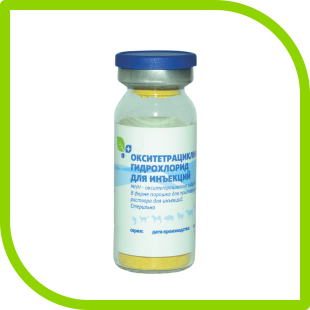
INSTRUCTIONS
of using oxytetracycline hydrochloride for injection for the treatment of farm animals in diseases of bacterial etiology
(organization-developer: BioKhimPharm, Raduzhny)
I. General information
1. Trade name of the medicinal product: Oxytetracycline hydrochloride for injection (Oxytetracyclini hydrochloridum pro injectionibus).
International Nonproprietary Name: oxytetracycline hydrochloride.
2. Dosage form: powder for solution for injection.
The drug as an active substance contains oxytetracycline hydrochloride – not less than 860 μg / mg (in terms of dry matter). In appearance, the preparation is a yellow crystalline powder.
3. Produce the preparation in the form of a sterile powder, prepacked by 0.5; 1.0 g (in terms of the active substance) in vials, sealed with rubber stoppers, reinforced aluminum caps.
4. Store the drug in the manufacturer’s closed container in a dry, protected from light place, separate from food and feed, at a temperature of 5 ° C to 25 ° C.
The shelf life of the medicinal product under the storage conditions is 3 years from the production date. After opening the vial the drug is not subject to storage.
Do not use oxytetracycline hydrochloride for injection at the expiration date.
5. Oxytetracycline hydrochloride for injection should be stored out of the reach of children.
6. Dispose of unused medicinal product in accordance with legal requirements.
II. Pharmacological properties
7. Oxytetracycline hydrochloride refers to antibacterial drugs from the group of tetracyclines.
Oxytetracycline hydrochloride, an antibiotic produced by Streptomyces rimosus, has a broad spectrum of antibacterial action. It is active against Streptococcus spp., Staphylococcus spp. (including strains producing penicillinase), Listeria spp., Bacillus anthracis, Clostridium spp., Actinomyces israelii, Haemophilus influenzae, Haemophilus ducreyi, Bordetella pertussis, Escherichia coli, Enterobacter spp. (including Enterobacter aerogenes), Klebsiella spp., Salmonella spp., Shigella spp., Yersinia pestis, Bartonella bacilliformis, Vibrio cholerae, Vibrio fetus, Rickettsia spp., Borrelia burgdorferi, Brucella spp., Neisseria gonorrhoeae, Treponema spp., Chlamydia spp ., Mycoplasma spp.
Oxytetracycline is resistant to: Pseudomonas aeruginosa, Proteus spp., Serratia spp., Most strains of Bacteroides spp., As well as fungi and viruses.
The mechanism of antibacterial action is based on suppression of protein synthesis of a microbial cell (blockade of ribosome function) and blockade of RNA synthesis.
Oxytetracycline hydrochloride, when administered intramuscularly, is rapidly absorbed from the injection site into the blood and easily penetrates most organs and tissues of the body. The maximum concentration of antibiotic in the blood is reached after 30 minutes, the therapeutic concentration in the organs and tissues is held for 10-12 hours. Oxytetracycline is excreted from the body mainly with urine.
Oxytetracycline hydrochloride according to the degree of exposure to the body according to GOST 12.1.007-76 refers to substances of low hazard (hazard class 4), in recommended doses does not have a local irritant effect.
III. The order of application
8. Oxytetracycline hydrochloride for injection is used by agricultural animals for the treatment of respiratory bacterial infections, colibacillosis, salmonellosis, pasteurellosis, gastroenterocolitis of bacterial etiology in young animals, mastitis, gynecological and other diseases caused by pathogens sensitive to antibiotics of the tetracycline group.
9. Contraindication to the use of the drug is the increased individual sensitivity of the animal to the antibiotics of the tetracycline group.
If the excretory function of the kidneys and liver diseases are disturbed, the drug should be administered with caution.
10. Before using the drug in the vial, puncture the vial with a needle, dissolve in 5-10 ml of water for injection, or sterile isotonic sodium chloride solution, or 1-2% sterile solution of novocaine.
The treatment solution is prepared immediately before administration, it is not subject to storage and heating.
The drug is administered to the animals intramuscularly at intervals of 10-12 hours for 5-7 days in the following doses (according to the active ingredient):
– calves up to 6 months of age and lambs up to 4 months of age – 9 mg / kg of animal weight;
– Pigs up to 6 months of age – 12 mg / kg of animal weight;
– cattle, pigs over 6 months of age and small cattle older than 4 months of age – 7 mg / kg of animal mass.
11. Symptoms of overdose in animals have not been identified.
12. Features of the drug during its first use or withdrawal is not revealed.
13. Passage of the next dose of the drug should be avoided, as this can lead to a decrease in its therapeutic effectiveness. In the case of missing one dose, the drug is resumed in the same dosage and according to the same schedule.
14. When oxytetracycline hydrochloride is used for injection in accordance with this instruction, adverse events and complications in animals are generally not observed. With increased individual sensitivity of the animal to antibiotics of the tetracycline group, rapidly developing allergic reactions (skin rash, itching, eosinophilia), angioedema, nausea, diarrhea, thrombocytopenia, hemolytic anemia are sometimes manifested in animals. In this case, the drug is discontinued and desensitizing therapy is administered.
Long-term use of drugs of the tetracycline group can cause an increase in the activity of hepatic transaminases, hyperbilirubinemia, increased urea concentration, and complications resulting from the development of candidiasis. In this case, the drug is discontinued and antimycotic antibiotics are used to treat candidiasis.
15. It is prohibited to use oxytetracycline hydrochloride for injection simultaneously with aminoglycosides, penicillins, cephalosporins, levomycetin, erythromycin, sulfonamides.
16. Slaughter of animals for meat is allowed no earlier than 6 days after the last application of oxytetracycline hydrochloride for injection. The meat of animals, who were forcedly killed before the expiration of the specified period, can be used in feed for carnivorous animals.
Milk, obtained from animals during the treatment period and within 2 days after the last administration of the drug, is prohibited for use for food purposes. Such milk after heat treatment can be used in animal feed.
IV. Personal prevention measures
17. In the conduct of treatment activities using oxytetracycline hydrochloride for injection, the general rules of personal hygiene and safety precautions prescribed in dealing with medicinal products should be observed. While working with the drug, it is forbidden to drink, smoke and eat. At the end of work, hands should be washed with warm water and soap.
18. People with hypersensitivity to oxytetracycline should avoid direct contact with the drug. In case of accidental ingestion of the drug on the skin or mucous membranes, it must be rinsed with a stream of running water. In case of allergic reactions, as well as getting the medication inside, you should immediately go to a medical institution (with you to have instructions for the use of the drug or a label).
19. Empty vials from a medicinal product should not be used for domestic purposes, they must be disposed of with household waste.





